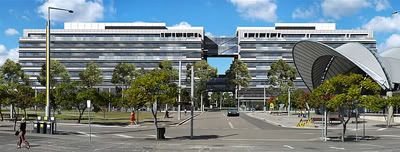Commonwealth Bank
 Commonwealth Financial Centre | |
| Headquarters | Philadelphia |
| Central Bank of | United Kingdom |
| Currency | Oceania Pound |
| Base Borrowing Rate | 3.25% |
| Printer | Commonwealth Bank |
| Minter | Commonwealth Bank |
The Commonwealth Bank is the central bank for the United Kingdom and is therefore responsible for the monetary policy of the United Kingdom. Located in Philadelphia, the Commonwealth Bank has served as the bank of the Government since the Commonwealth of Azazia received independence in 1912.
History
In 1910, with independence or home rule anticipated by the colonial government in Georgetown passed the Commonwealth Bank Act, which authorised the creation of a bank for the colony, which had begun to anticipate its independence. With independence in 1912, the Commonwealth Bank seamlessly adopted its new role as the manager of the nascent nation’s monetary policy. Throughout the middle part of the century, the Commonwealth Bank issued money and minted coins while reviewing and adjusting the long-term and short-term interest rates as the economic situation of the Commonwealth of Azazia warranted.
The first real reform of the Commonwealth Bank was carried out in 1980 by the Conservative government of Geoffrey Hedley. After a series of bank closures and mergers, the general public as well as the government became concerned about the dual-nature of the Commonwealth Bank, which still functioned as both a general bank and a central bank. The Commonwealth Bank Act of 1980 thus split the bank with both parties retaining the name. The only difference being the nature of the bank, the central bank remained a government authority while the general bank became a publicly traded company, Commonwealth Bank plc.
In 1996, the Democratic Socialist government of Reginald Baker passed the Commonwealth Bank Act of 1996 at the bequest of the Chancellor of the Exchequer, Alistair Tetley. Importantly, the bill separated the government from the bank in an attempt to limit the influence of the sitting government upon monetary policy. However, to pass the bill in the House of Commons, the bill was amended to allow the Governor of the bank to remain appointed by the sitting government.
In 2006, the bank finished construction of the Commonwealth Financial Centre in Philadelphia, allowing the bank to move from its previous headquarters in Imperium to the financial capital of the UK. The building complex also includes a building for the general bank, Commonwealth Bank plc, which still maintains the name and historical links for brand and identity purposes.
Functions
The Commonwealth Bank is responsible for the monetary and fiscal stability of the United Kingdom, which it enables in a largely politically neutral fashion since its near complete separation from the Government in 1996. As part of the programme to create stability, and thereby prosperity, the bank is responsible for several key elements of Oceanian monetary and fiscal policy:
- the evaluation and alteration of base interest rates to keep inflation low, typically within 3% per annum
- monitoring confidence in the Oceania Pound
- monitoring and maintaining the financial security of the United Kingdom through intelligence operations and then financial operations domestically and, where necessary, internationally
- acting as a lender of last resort in case of bank failures
- printer, minter, and issuer of Oceanian currency
- management of foreign exchange and precious metal reserves
